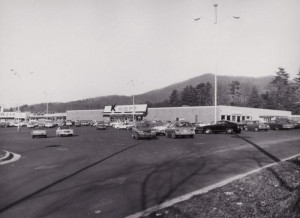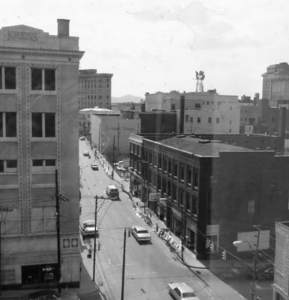
By the 1980s, Asheville was like most other cities in the U.S., needing major renovations and repairs in order to boost the economy of the area. The Great Depression had hit the country hard almost everywhere, but Asheville saw some of the biggest losses in their economic standings. Molly Sager discusses in her thesis concerning downtown Asheville and the mall project that, “Asheville’s debt in 1930 exceeded that of Raleigh, Durham, Winston-Salem, and Greensboro combined. The city was on the verge of bankruptcy, unable to fulfill its debt. The city agreed to a restructuring plan in 1939 but it would not be until 1976, a full 46 years later, that the debt would be retired.”[ref] Molly Sager, “The Mall That Almost Ate Asheville: The Fight between City Hall and Save Downtown Asheville Inc. Over the Strouse, Greenberg & Company Downtown Commercial Complex” (Undergraduate Thesis, University of North Carolina at Asheville, 2012), 7-8.[/ref] The lack of public spending money during the years after the Great Depression kept the city from putting money towards the downtown area. The idea of revitalizing downtown areas was not a new concept in America and in other cities throughout the country, people’s rapid migration from cities to suburbia and the growth of the automobile, created a desire for shopping centers. Asheville soon recognized the booming shopping centers and the first mall in the Asheville was created on Tunnel Road in 1971. The mall devastated the downtown area and slowly all the big department stores left downtown. With all the major stores moving to the Asheville Mall, most of the buildings they had occupied remained vacant afterwards and began to affect the businesses surrounding the old department stores who relied on them to bring customers downtown. By the late 1970s, the downtown area was boarded up, unemployment was on the rise, and the tax revenues were declining.[ref]Bernard J. Frieden and Lynne B. Sagalyn, Downtown, Inc.: How America Rebuilds Cities (Cambridge, MA: MIT Press, 1989), 281[/ref]

City officials were faced with major problems about the condition of downtown and what method would be most beneficial in revitalizing the area. In 1977, Asheville’s City Council established the Asheville Revitalization and Economic Redevelopment Commission or more commonly known as the ARC. The ARC proposed a plan to create a redeveloped urban core for the city of Asheville by investing time and money into the preservation of the buildings in the area. The ARC was interested in keeping what was good in Asheville and cleaning up the bad. In the late 1970s, private money and small business owners were already beginning to invest in the ARC’s project.[ref]Nan K. Chase, Asheville: A History (Jefferson, NC: McFarland &, 2007), 91-95.[/ref]
In addition to the ARC’s plans, a former Asheville architect, John L. Lantzius, began purchasing numerous buildings in the Lexington Park area of downtown. Lantzius’s buildings were all renovated, repainted, and sold or rented out to tenants. By 1980, his visions for Lexington Park aligned nicely with the preservation plans of the ARC. Lantizius’s plans called for downtown to become an open market place and place to shop, eat, and be entertained.[ref]John Lantzius, In “Lexington’s Changing Face,” By Bob Terrell, The Asheville Citizen, September 30, 1977.[/ref]
Downtown Asheville Mall Timeline:
